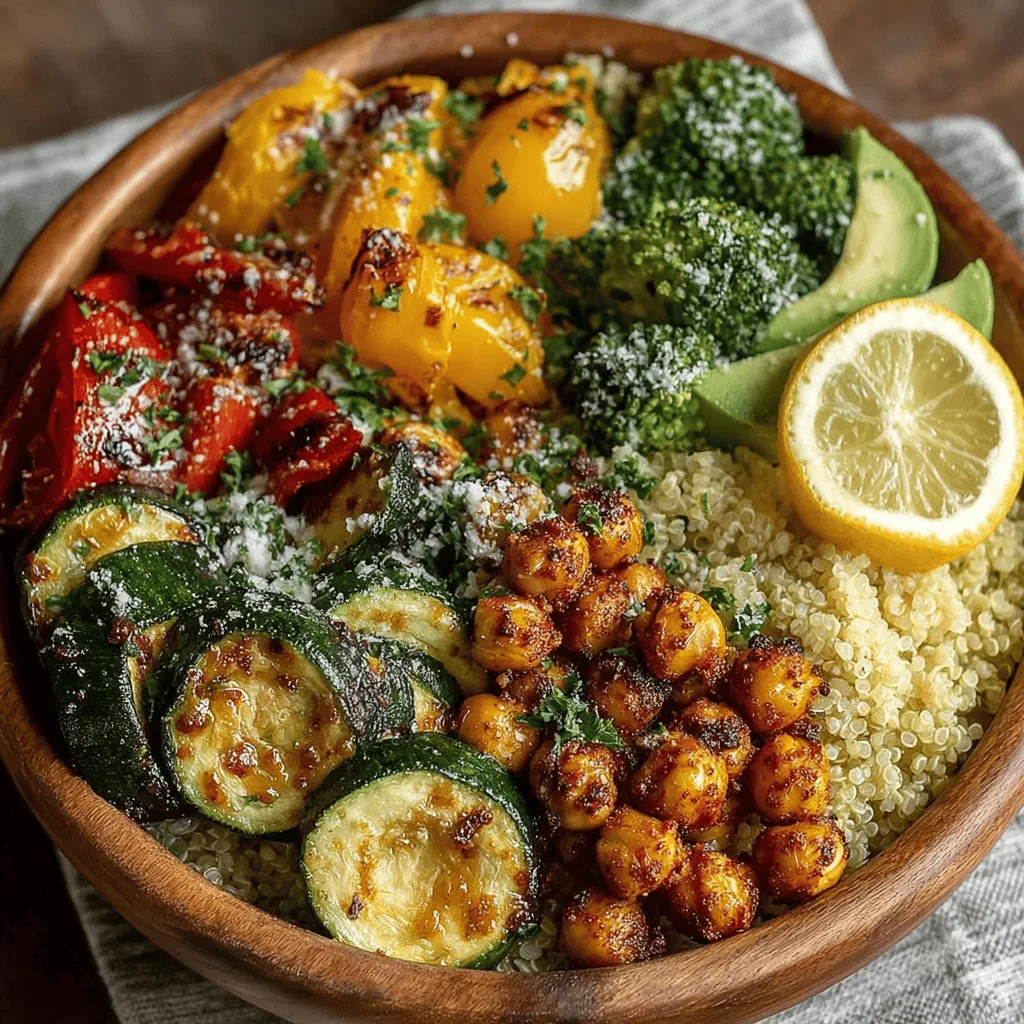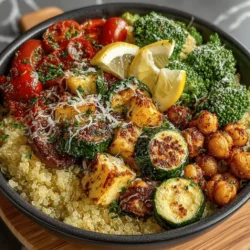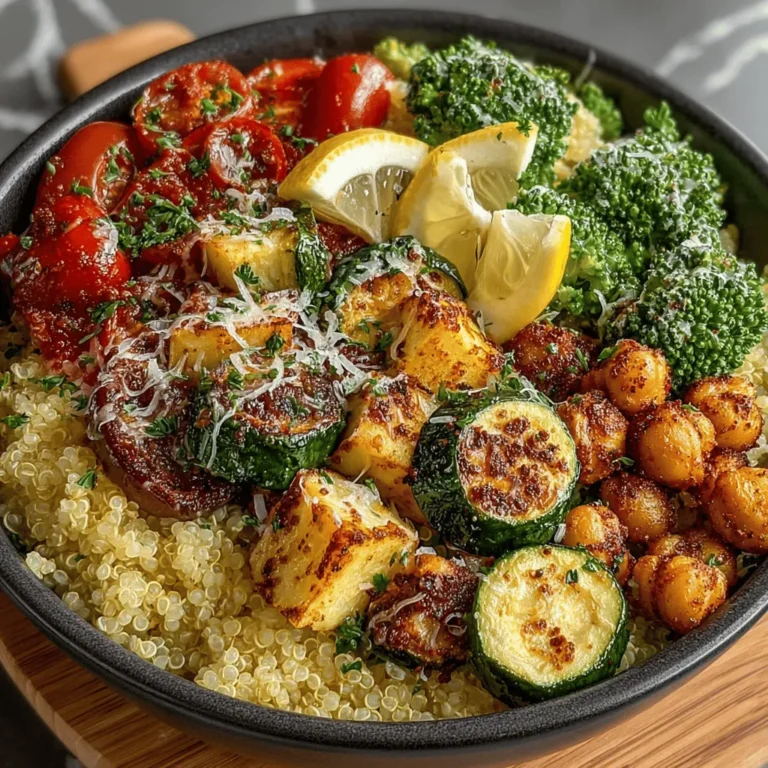Vibrant Quinoa and Roasted Veggie Power Bowls: A Deliciously Nutritious Choice
In recent years, the popularity of plant-based meals has surged, reflecting a broader trend toward healthier eating habits. As people become increasingly aware of the benefits of incorporating more plant-based foods into their diets, recipes that prioritize vegetables, whole grains, and legumes are gaining traction. One such dish that embodies this trend is the Vibrant Quinoa and Roasted Veggie Power Bowl. This recipe not only tantalizes the taste buds with its array of colors and flavors but also packs a nutritional punch, making it an excellent choice for anyone looking to enhance their diet with wholesome ingredients.
The Vibrant Quinoa and Roasted Veggie Power Bowl is a perfect representation of how delicious and satisfying plant-based meals can be. It combines protein-rich quinoa with an assortment of roasted vegetables, creating a colorful, nutrient-dense dish that appeals to various dietary preferences, including vegetarian, vegan, and gluten-free diets. Its versatility allows for easy customization based on personal tastes or seasonal availability, ensuring that this dish can be enjoyed year-round.
Understanding the Ingredients
To truly appreciate the Vibrant Quinoa and Roasted Veggie Power Bowl, it’s essential to understand the individual components that make it so nutritious and flavorful.
Quinoa: The Protein-Packed Grain
At the heart of this power bowl is quinoa, a pseudo-grain that has gained popularity for its exceptional nutritional profile. Unlike many grains, quinoa is a complete protein, meaning it contains all nine essential amino acids that the body cannot produce on its own. This quality makes it a valuable protein source for those following plant-based diets. Additionally, quinoa is rich in fiber, vitamins, and minerals, including magnesium, phosphorus, and B vitamins. Its nutty flavor and fluffy texture make it an ideal base for a variety of dishes.
Roasted Vegetables: A Colorful Array of Nutrients
The vegetables used in this recipe—zucchini, red bell pepper, cherry tomatoes, broccoli, and red onion—each bring their own unique flavors and health benefits to the table.
– Zucchini is low in calories and high in water content, making it an excellent addition for hydration. It also provides a good source of vitamin C and antioxidants, which can help boost the immune system.
– Red bell pepper is not only vibrant in color but also packed with nutrients. It is an excellent source of vitamin A and vitamin C, both of which play crucial roles in eye health and immune function, respectively.
– Cherry tomatoes are rich in lycopene, a powerful antioxidant known for its potential cancer-fighting properties. They also contribute a natural sweetness to the dish.
– Broccoli is a nutrient powerhouse, loaded with vitamin K, vitamin C, and fiber. Its sulforaphane content has been linked to various health benefits, including anti-inflammatory effects.
– Red onion adds a sharp flavor that complements the sweetness of the other vegetables. It contains quercetin, an antioxidant that may help lower blood pressure and reduce inflammation.
When sourcing these vegetables, consider purchasing them from local farmers’ markets or grocery stores that prioritize seasonal produce. This not only supports local agriculture but also ensures peak freshness and flavor.
Chickpeas: A Legume for All Seasons
In addition to quinoa and vegetables, this recipe includes chickpeas, which are a staple in plant-based diets. Chickpeas are a fantastic source of plant protein, providing approximately 14.5 grams of protein per cup. They are also high in fiber, which can aid in digestion and promote a feeling of fullness. Incorporating chickpeas into your power bowl not only enhances the dish’s nutritional value but also adds a creamy texture that balances the crunch of the roasted vegetables.
Extra Virgin Olive Oil: The Heart-Healthy Fat
To elevate the flavors of the power bowl, extra virgin olive oil is used. This healthy fat is known for its heart-healthy properties, including high levels of monounsaturated fats and antioxidants. Drizzling olive oil over the vegetables before roasting enhances their natural flavors and promotes nutrient absorption, especially for fat-soluble vitamins.
Seasonings: Elevating Flavor Profiles
The seasonings used in this recipe—garlic powder and smoked paprika—play an essential role in developing the overall flavor profile. Garlic powder adds a subtle depth and warmth, while smoked paprika contributes a rich, smoky flavor that complements the sweetness of the roasted vegetables. Both seasonings offer additional health benefits, including anti-inflammatory properties and potential heart health support.
Step-by-Step Preparation Guide
Now that we’ve explored the ingredients that make up the Vibrant Quinoa and Roasted Veggie Power Bowl, it’s time to dive into the preparation process. Following these steps will ensure that each element of the dish is cooked to perfection, resulting in a harmonious blend of flavors and textures.
1. Preheating the Oven
The first step in preparing your power bowl is to preheat your oven. Set it to 425°F (220°C). Preheating is crucial for achieving that perfect roasted flavor and texture. A hot oven ensures that the vegetables caramelize nicely, enhancing their natural sweetness and creating a delightful contrast in your bowl.
2. Preparing the Quinoa
While the oven is heating, it’s time to prepare the quinoa. Rinse 1 cup of quinoa under cold water to remove any bitterness from the outer coating called saponin. Then, combine the rinsed quinoa with 2 cups of water or vegetable broth in a medium saucepan. Bring it to a boil over medium-high heat, then reduce the heat to low, cover the saucepan, and let it simmer for about 15 minutes, or until the quinoa has absorbed all the liquid and appears fluffy. Once cooked, remove it from heat and let it sit for 5 minutes before fluffing it with a fork. This step is essential for achieving the ideal texture—light and airy, rather than mushy.
3. Roasting the Vegetables
While the quinoa is cooking, it’s time to prepare the vegetables for roasting. Start by washing and chopping the zucchini, red bell pepper, cherry tomatoes, broccoli, and red onion into bite-sized pieces. Aim for uniform sizes to ensure even cooking.
Next, place the chopped vegetables in a large mixing bowl and drizzle with 2 tablespoons of extra virgin olive oil. Sprinkle with garlic powder and smoked paprika, along with salt and pepper to taste. Toss everything together until the vegetables are well coated in the oil and seasonings.
Spread the seasoned vegetables in a single layer on a baking sheet lined with parchment paper. This step is important as it allows each piece to roast evenly, developing a rich flavor and appealing texture. Place the baking sheet in the preheated oven and roast for about 20-25 minutes, or until the vegetables are tender and slightly charred.
By mastering these initial steps, you set the foundation for a deliciously vibrant and nutritious meal. The combination of fluffy quinoa and perfectly roasted vegetables creates a power bowl that is not only appealing to the eyes but also nourishing for the body. As you continue through the recipe, you will discover the joy of assembling and customizing your power bowl, making it a delightful addition to your culinary repertoire.

Tips for Cutting Vegetables Uniformly for Consistent Roasting
Achieving perfectly roasted vegetables begins with how you cut them. Here are some essential tips to ensure uniformity in size and shape, which promotes even cooking and enhances the overall presentation of your Vibrant Quinoa and Roasted Veggie Power Bowls:
1. Use a Sharp Knife: A sharp knife will make clean cuts and reduce the risk of crushing the vegetables, which can lead to uneven cooking.
2. Choose a Consistent Size: Aim for pieces that are approximately the same size. For most vegetables, 1-inch cubes work well. This size allows them to roast evenly and caramelize beautifully.
3. Consider the Vegetable Type: Hard vegetables like carrots and potatoes may require slightly larger cuts than softer vegetables like zucchini or bell peppers, which cook faster.
4. Use a Mandoline: For vegetables like carrots or zucchini, a mandoline slicer can create uniform slices quickly and efficiently.
5. Prep Ahead: If you’re preparing vegetables in advance, store them in an airtight container, ensuring that the moisture is minimized to prevent sogginess.
By following these tips, you will enhance the cooking process and the final aesthetic of your Power Bowls.
Cooking Chickpeas: Methods for Adding Texture and Flavor
Chickpeas are a staple in many vegetarian and vegan dishes, providing a delightful texture and a good source of protein. Here are several methods to prepare them for your power bowls:
Canned Chickpeas
1. Rinse and Drain: Start by rinsing canned chickpeas under cold water to remove excess sodium and improve their taste.
2. Roasting: For a crunchier texture, toss drained chickpeas with olive oil, salt, and spices (like paprika or cumin) and roast them at 400°F (200°C) for about 20-30 minutes until crispy.
Dried Chickpeas
1. Soaking: If you prefer dried chickpeas, soak them overnight in water to hydrate. Use a ratio of about 1 cup of chickpeas to 3 cups of water.
2. Cooking: Drain and rinse the soaked chickpeas, then cook them in fresh water (about 1.5 cups of water per cup of chickpeas) for 1-2 hours on the stovetop until tender. You can also use a pressure cooker for faster results.
3. Flavoring: Add garlic, bay leaves, or onion to the cooking water for added flavor. After cooking, season with salt and your favorite spices.
Seasoning Options
For both canned and dried chickpeas, consider seasoning them post-cooking with lemon juice, fresh herbs, or spices to enhance their flavor profile. This step elevates the taste and makes them a vibrant addition to your power bowls.
Assembling the Bowls: Creative Presentation Ideas to Enhance Visual Appeal
Presentation is key when it comes to making your Vibrant Quinoa and Roasted Veggie Power Bowls visually appealing. Here are some creative ideas:
1. Layering: Start with a base of quinoa at the bottom of the bowl. Layer roasted veggies on top, followed by chickpeas for texture.
2. Color Contrast: Use a variety of vegetables to create a colorful display. Bright red bell peppers, deep green broccoli, and golden sweet potatoes not only taste great but also make the dish look inviting.
3. Garnishing: Top your bowl with fresh herbs like parsley or cilantro, and a sprinkle of seeds or nuts for added crunch. You can also drizzle a sauce or dressing over the top for a finishing touch.
4. Serving Size: Use larger bowls for a meal or smaller bowls for appetizers. This versatility allows you to cater to various occasions.
5. Create a Drizzle: Prepare a flavorful dressing, such as tahini or balsamic vinaigrette, and drizzle it over the assembled bowl for added flavor and visual appeal.
Nutritional Analysis of the Power Bowl
Breakdown of the Nutritional Content per Serving
Each serving of your Vibrant Quinoa and Roasted Veggie Power Bowl is not only visually appealing but also packed with nutrients. Here’s a typical nutritional breakdown for one serving:
– Calories: Approximately 400-450 kcal
– Protein: 15-18 grams
– Carbohydrates: 60-65 grams
– Fiber: 12-15 grams
– Fat: 10-15 grams
This makes it a well-rounded meal that can fuel your day.
Comparison to Traditional Meal Options
When compared to traditional meat-based dishes, these power bowls stand out in terms of health benefits. A typical serving of chicken and rice might contain similar calories but often lacks the fiber and phytonutrients found in a plant-based dish. Additionally, the saturated fat content in meat dishes can be significantly higher, making plant-based meals a healthier alternative for heart health.
Benefits of Incorporating More Plant-Based Meals
Incorporating plant-based meals like the Vibrant Quinoa and Roasted Veggie Power Bowls into your diet can lead to numerous health benefits, including:
– Improved Digestive Health: The high fiber content promotes a healthy gut.
– Weight Management: Plant-based meals are generally lower in calories and high in nutrients, making them ideal for weight loss.
– Reduced Risk of Chronic Diseases: Diets rich in fruits, vegetables, and whole grains are associated with a lower risk of heart disease, diabetes, and certain cancers.
Flavor Variations and Customizations
Suggestions for Alternative Vegetables
One of the best features of the Vibrant Quinoa and Roasted Veggie Power Bowls is their versatility. Based on seasons or personal preferences, you can easily swap out vegetables:
– Spring: Use asparagus, peas, and radishes.
– Summer: Incorporate zucchini, cherry tomatoes, and bell peppers.
– Autumn: Opt for root vegetables like butternut squash, carrots, and Brussels sprouts.
– Winter: Consider using hearty greens like kale or collard greens along with sweet potatoes.
Possible Add-Ins
To further enhance your power bowls, consider these add-ins:
– Nuts and Seeds: Almonds, walnuts, pumpkin seeds, or sunflower seeds add a delightful crunch while offering healthy fats.
– Different Legumes: Substitute chickpeas with black beans, lentils, or edamame for additional protein and flavor.
Dressings and Sauces
Enhancing flavor profiles can be achieved through various dressings and sauces. Here are a few ideas:
– Tahini Sauce: Blend tahini with lemon juice, garlic, and a bit of water for a creamy drizzle.
– Balsamic Vinaigrette: Combine balsamic vinegar, olive oil, Dijon mustard, and honey for a sweet and tangy dressing.
– Spicy Peanut Sauce: Mix peanut butter, soy sauce, lime juice, and sriracha for a spicy kick.
Serving Suggestions
Ideal Occasions for Serving
Vibrant Quinoa and Roasted Veggie Power Bowls are perfect for various occasions:
– Meal Prep: Ideal for making ahead of time for busy weekdays, these bowls can be stored in the fridge for quick lunches.
– Family Gatherings: Serve as a colorful centerpiece at potlucks or family dinners, catering to both plant-based and non-plant-based eaters.
– Lunchboxes: A great option for school or work lunches, as they are nutritious, filling, and easy to transport.
Pairing Suggestions
To complement your power bowls, consider serving them with:
– Side Dishes: A light salad or a side of whole-grain bread can round out the meal.
– Beverages: Pair with a refreshing iced tea or a light sparkling water for a complete dining experience.
Conclusion
In summary, the Vibrant Quinoa and Roasted Veggie Power Bowls offer a delightful mix of flavors, textures, and colors, making them a feast for the eyes and the palate. The health benefits, including high fiber content and plant-based protein, make them an excellent choice for anyone looking to improve their diet.
Experimenting with different vegetables, legumes, and dressings allows you to customize this recipe to your liking, ensuring it becomes a staple in your meal rotation. Embracing plant-based eating not only nourishes your body but also introduces you to a world of vibrant flavors and culinary creativity. So, roll up your sleeves and start creating your personalized version of this delicious power bowl today!


